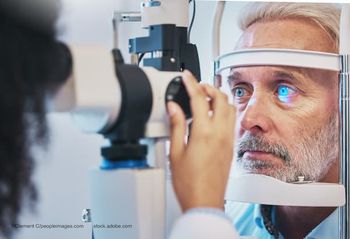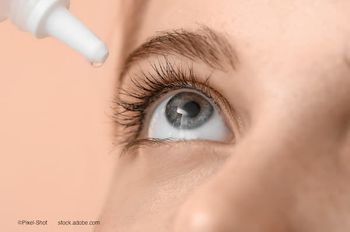
- Ophthalmology Times: November 1, 2021
- Volume 46
- Issue 18
Link between neurodevelopmental disorders, visual problems studied
Investigators find that youth show altered ocular movements, reduced amplitude of accommodation.
Neurodevelopmental disorders (NDDs) are characterized by early-onset deficits of variable severity in personal, social, academic, or occupational functioning, as defined in the Diagnostic and Statistical Manual of Mental Disorders, Fifth Edition (DSM-5).1 Developmental deficits may vary from very specific limitations of learning or control of executive functions to global impairments of social skills or intelligence.2
Alterations in ocular movements and a large variety of visual problems have been associated with certain types of NDDs in children, which has lent support to the idea that the NDDs represent an etiological factor.3-12 Specifically, different types of accommodative, binocular, and oculomotor alterations have been reported in dyslexia, attention deficit/hyperactivity disorder (ADHD), and developmental coordination disorder (DCD).
Investigations carried out to date only suggest the potential for visual problems to be a comorbidity in these conditions, so it cannot be concluded that these alterations are causal factors. Indeed, one hypothesis proposes that the concept of dorsal stream vulnerability can be used to explain a cluster of problems that are common to many NDDs, including poor motion sensitivity, visuomotor spatial integration for planning actions, attention, and number skills.13,14
To attempt to shed more light on the link between visual problems and NDDs, we recently conducted a clinical study to analyze the distribution of oculomotor and visual alterations, defined according to standard clinical tests in children with dyslexia, ADHD, and DCD (3 of the more common NDDs that can be examined easily in clinical practice). We compared the distribution with that obtained in healthy children without ocular pathology but with and without oculomotor anomalies.15,16
Our research
We evaluated a total of 69 children (6 to 13 years old) in a prospective, nonrandomized comparative study, conducted at the Child Development Unit of the Alto Aragón Polyclinic in Huesca, Spain. All children were evaluated by an optometrist, an ophthalmologist, a speech therapist, a psychologist, and a neuropediatrician.
Among the children recruited for the study, 3 groups were clearly differentiated. These included a control group; healthy children with oculomotor abnormalities; and children with an NDD diagnosis. No comorbidity of NDD was present in any case.
A complete visual examination was conducted, including the measurement of uncorrected and corrected distance visual acuity; manifest and cycloplegic refraction; a cover test; a Maddox rod test; the measurement of near point of convergence (NPC); distance and near stereopsis; a Worth Four Dot Test; fusional vergence measurement; monocular and binocular accommodative facility; amplitude of accommodation; accommodative response at 40 cm (monocular estimation method); and a subjective evaluation of oculomotricity with the Northeastern State University College of Optometry (NSUCO) oculomotor test and the developmental eye movement (DEM) test.
An objective evaluation of oculomotricity was carried out with the eye tracker Tobii EyeX (Tobii) and Clinical Eye Tracker software (Thomson Software Solutions) in a subsample of 15 healthy children and 17 children with NDDs.
Our results
We found significantly worse near stereopsis in children with NDDs compared with healthy children (60.1 ± 71.2 vs 30.7 ± 23.9 in; P < .001) and in those with oculomotor abnormalities but without NDDs (60.1 ± 71.2 vs 30.8 ± 18.9 in; P = .001). Likewise, a significantly lower amplitude of accommodation was found in children with NDDs compared with healthy children in both the right eye (11.4 ± 2.8 vs 9.0 ± 2.0 D; P = .001) and the left eye (10.1 ± 2.8 vs 9.2 ± 1.9 D; P < .001).
No statistically significant differences between the groups were found in the measurement of near and distance phoria (P ≥ .557), NPC (P = .700), and fusional vergences (P ≥ .059). According to standard criteria, no statistically significant differences were present among the groups in the number of cases with binocular or accommodative disorders (P ≥ .471).
The comparison between the 3 types of NDDs included revealed the presence of a significantly lower amplitude of accommodation in children with DCD compared with those with dyslexia. Furthermore, less exophoria at near was present in children with dyslexia compared with children with ADHD
(P = .018) and DCD (P = .054).
Concerning oculomotricity, significantly impaired scores were found with the subjective test (NSUCO and DEM tests) in children with NDDs compared with healthy children (P < .001), with no significant differences between children with oculomotor abnormalities but without NDDs and children with NDDs (P ≥ .063). Regarding eye tracking analyses, we found a significantly higher number of hypometric saccades in children with NDDs compared with healthy children (P ≤ .044).
A complete visual examination was conducted, including measurement of uncorrected and corrected distance visual acuity; manifest and cycloplegic refraction; cover test; Maddox rod test; measurement of near point of convergence (NPC); distance and near stereopsis; four-dot Worth test; fusional vergence measurement; monocular and binocular accommodative facility; amplitude of accommodation; accommodative response at 40 cm (monocular estimation method); and subjective evaluation of oculomotricity with Northeastern State University College of Optometry’s Oculomotor (NSUCO) and developmental eye movement (DEM) test.
An evaluation of oculomotricity was carried out with the Eye Tracker Tobii Eye X (Tobii) and the Clinical Eye Tracker software (Thomson Software Solutions) in a subsample of 15 healthy children and 17 children with NDDs.
Likewise, we found a significantly higher percentage of regressions in the group of children with NDDs when a time interval of presentation between stimuli of 1 second was used (P = .012). Significant correlations were found between different NSUCO scores and percentage of regressions, number of saccades completed, and number of hypometric saccades.
Conclusions
Children with dyslexia, ADHD, and DCD show an altered oculomotor pattern and a more reduced amplitude of accommodation; however, this is not always compatible with the diagnostic criteria of an accommodative insufficiency. Accommodative and binocular vision problems are not always present in these children and so cannot be considered an etiological factor.
Hypometric saccades and regressions are commonly present in children with NDDs. However, oculomotor anomalies can be present in children with and without NDDs, and therefore they do not seem to be a good diagnostic criterion of these complex types of disorders.
Future research should be focused on the analysis of the impact of oculomotor alterations associated with NDDs and how complementary binocular and accommodative anomalies affect the child’s development. This is critical because it will help define a standardized scientific-based approach for the treatment of visual and oculomotor problems in children with NDDs. This, in turn, will help prevent exposure to pseudotherapies and treatments based on visual approaches that are not useful.
Carmen Bilbao, MSc
Bilbao is based at the Department of Optometry, Policlínica Alto Aragón in Huesca, Spain. She has no financial disclosures related to this content.
David P. Piñero, PhD
Piñero is part of the Optics and Visual Perception Group, Department of Optics, Pharmacology and Anatomy at the University of Alicante in Spain, and is based at the Department of Ophthalmology, Vithas Medimar International Hospital in Alicante. He has no disclosures related to this content.
References
1. American Psychiatric Association. Diagnostic and Statistical Manual of Mental Disorders (DSM-5). 5th ed. American Psychiatric Publishing; 2013.
2. Posar A, Visconti P. Neurodevelopmental disorders between past and future. J Pediatr Neurosci. 2017;12(3):301-302. doi:10.4103/jpn.JPN_95_17
3. Bilbao C, Piñero DP. Diagnosis of oculomotor anomalies in children with learning disorders. Clin Exp Optom. 2020;103(5):597-609. doi:10.1111/cxo.13024
4. Bilbao C, Piñero DP. Clinical characterization of oculomotricity in children with and without specific learning disorders. Brain Sci. 2020;10(11):836. doi:10.3390/brainsci10110836
5. Molina R, Redondo B, Vera J, García JA, Muñoz-Hoyos A, Jiménez R. Children with attention-deficit/hyperactivity disorder show an altered eye movement pattern during reading. Optom Vis Sci. 2020;97(4):265-274. doi:10.1097/OPX.0000000000001498
6. Hussaindeen JR, Shah P, Ramani KK, Ramanujan L. Efficacy of vision therapy in children with learning disability and associated binocular vision anomalies. J Optom. 2018;11(1):40-48. doi:10.1016/j.optom.2017.02.002
7. Falkenberg HK, Langaas T, Svarverud E. Vision status of children aged 7-15 years referred from school vision screening in Norway during 2003-2013: a retrospective study. BMC Ophthalmol. 2019;19(1):180. doi:10.1186/s12886-019-1178-y
8. Mahone EM, Mostofsky SH, Lasker AG, Zee D, Denckla MB. Oculomotor anomalies in attention-deficit/hyperactivity disorder: evidence for deficits in response preparation and inhibition. J Am Acad Child Adolesc Psychiatry. 2009;48(7):749-756. doi:10.1097/CHI.0b013e3181a565f1
9. Loe IM, Feldman HM, Yasui E, Luna B. Oculomotor performance identifies underlying cognitive deficits in attention-deficit/hyperactivity disorder. J Am Acad Child Adolesc Psychiatry. 2009;48(4):431-440. doi:10.1097/CHI.0b013e31819996da
10. Bucci MP, Brémond-Gignac D, Kapoula Z. Poor binocular coordination of saccades in dyslexic children. Graefes Arch Clin Exp Ophthalmol.2008;246(3):417-428. doi:10.1007/s00417-007-0723-1
11. Grisham D, Powers M, Riles P. Visual skills of poor readers in high school. Optometry. 2007;78(10):542-549. doi:10.1016/j.optm.2007.02.017
12. Kapoula Z, Bucci MP, Jurion F, Ayoun J, Afkhami F, Brémond-Gignac D. Evidence for frequent divergence impairment in French dyslexic children: deficit of convergence relaxation or of divergence per se? Graefes Arch Clin Exp Ophthalmol. 2007;245(7):931-936. doi:10.1007/s00417-006-0490-4
13. Atkinson J. The Davida Teller Award Lecture, 2016: visual brain development: a review of “dorsal stream vulnerability” – motion, mathematics, amblyopia, actions, and attention. J Vis. 2017;17(3):26. doi:10.1167/17.3.26
14. Braddick O, Atkinson J, Akshoomoff N, et al. Individual differences in children’s global motion sensitivity correlate with TBSS-based measures of the superior longitudinal fasciculus. Vision Res. 2017;141:145-156. doi:10.1016/j.visres.2016.09.013
15. Bilbao C, Piñero DP. Objective and subjective evaluation of saccadic eye movements in healthy children and children with neurodevelopmental disorders: a pilot study. Vision (Basel). 2021;5(2):28. doi:10.3390/vision502002816.
16. Bilbao C, Piñero DP. Distribution of visual and oculomotor alterations in a clinical population of children with and without neurodevelopmental disorders. Brain Sci. 2021; 11(3):351. doi:10.3390/brainsci11030351
Articles in this issue
about 4 years ago
Investigators use gene therapy treatment of Fuchs in animal modelsabout 4 years ago
EYS gene complexity key to treatment of retinitis pigmentosaabout 4 years ago
Netarsudil provides IOP lowering in goniotomy treated eyesabout 4 years ago
Fundraising for vision restorationabout 4 years ago
Robotically aligned OCT has potential for use in telemedicineabout 4 years ago
Seven pearls for a more stable chamberNewsletter
Don’t miss out—get Ophthalmology Times updates on the latest clinical advancements and expert interviews, straight to your inbox.















































.png)


